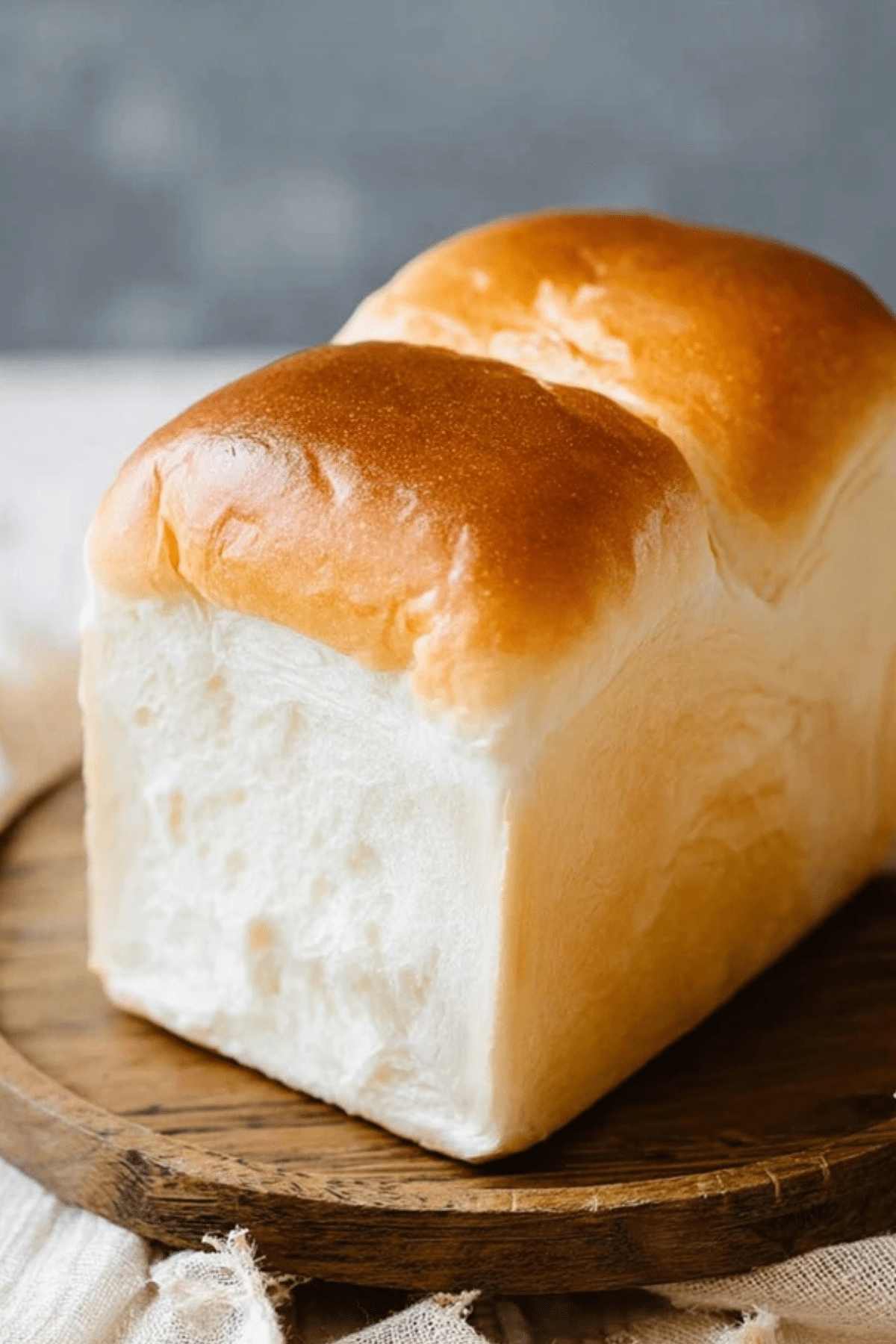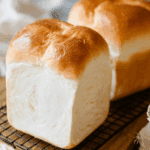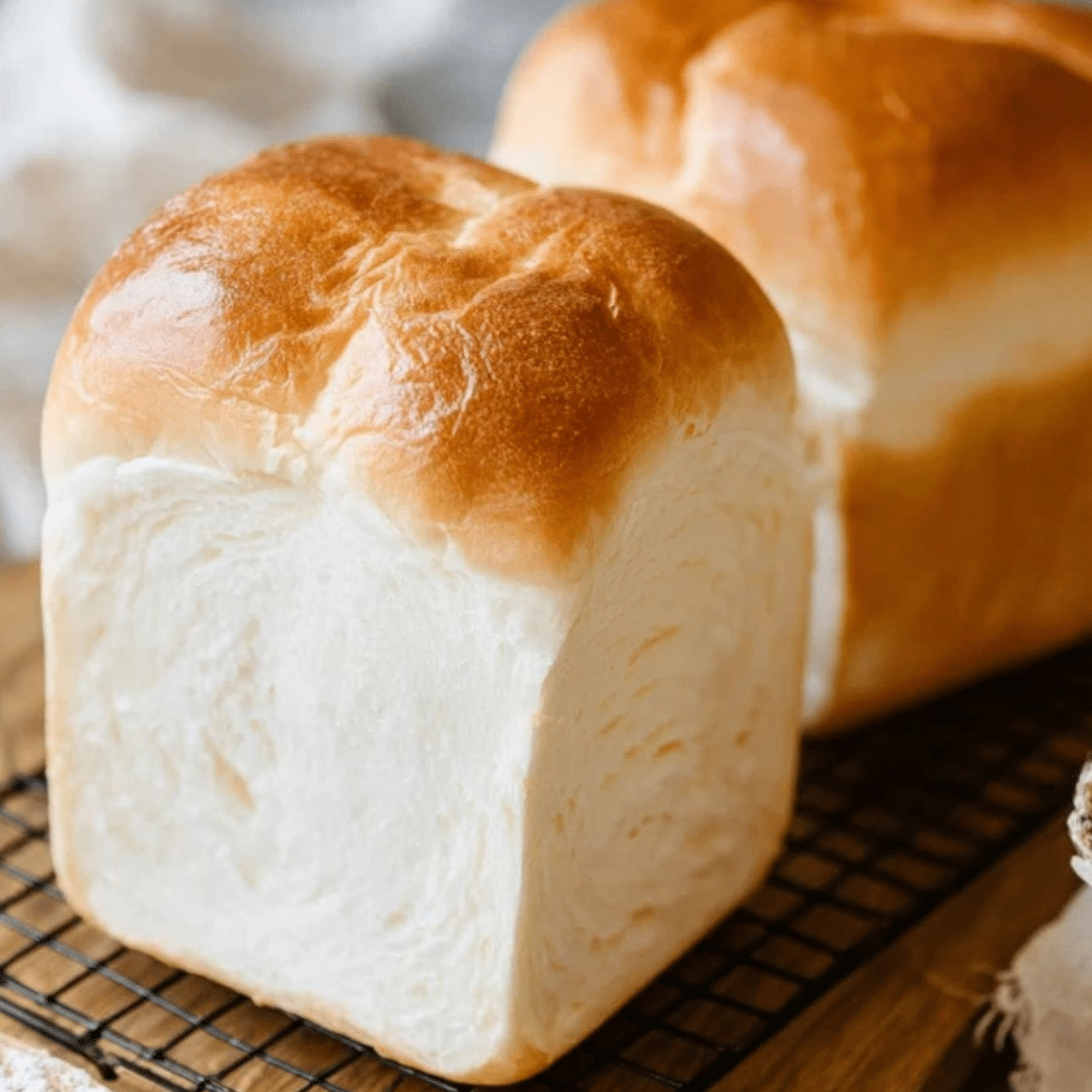Shokupan, also known as Japanese milk bread, is a soft, pillowy loaf that is loved for its fluffy texture and delicate sweetness. Whether you’re in Japan or making it at home, this bread’s iconic lightness makes it perfect for everything from sandwiches to simple toast. If you’ve ever craved a loaf that’s both tender and moist, Shokupan is your answer. Using the traditional Yudane method, this bread remains soft for days, making it the ideal addition to your baking repertoire.
Table of Contents
What Makes Shokupan So Irresistible?
The secret behind Shokupan’s exceptional softness lies in the Yudane method, which is a unique process of mixing hot water with bread flour. This technique gelatinizes the starches in the flour, keeping the bread moist for a longer time while ensuring a soft, smooth texture. The result is a loaf with a subtle sweetness and a soft, airy crumb that’s perfect for any time of day. Whether you’re a beginner or an experienced baker, this recipe allows you to achieve bakery-quality Shokupan right in your kitchen.
Ingredients
Gather these key ingredients for a fluffy, delicious Shokupan:
• Bread Flour: This high-protein flour (12% protein) helps create a soft, structured loaf.
• Hot Water: Boiling water activates the Yudane method, giving the bread its signature texture.
• Milk: Adds richness and moisture to the dough.
• Sugar: Enhances sweetness without overpowering the bread’s delicate flavor.
• Instant Yeast: Helps the dough rise to perfection for a light, airy loaf.
• Unsalted Butter: Adds richness and softens the texture.
• Salt: Balances the sweetness and helps with gluten formation.
Alternative Ingredient Suggestions
• Dairy-Free Milk: For a dairy-free version, swap regular milk with almond or coconut milk.
• Fresh Yeast: If you don’t have instant yeast, you can substitute with fresh yeast (3 times the weight).
• Butter Substitute: If you’re looking to avoid butter, you can replace it with vegetable oil, though the texture might slightly differ.
Step-by-Step Instructions
- Prepare the Yudane: The night before, mix 50g of bread flour with 40ml of hot water (above 194°F/90°C). Stir well and allow it to rest overnight in the refrigerator.
- Combine Ingredients: The next day, pour room temperature milk into the mixing bowl. Add sugar, yeast, and softened butter. Tear the Yudane into small pieces and add it to the mix.
- Knead the Dough: Add 200g of bread flour and 5g of salt to the mixture. Using a stand mixer or hand kneading, combine all ingredients. Knead for about 20 minutes until smooth.
- First Rise: Transfer the dough into a greased bowl, cover it with plastic wrap, and let it rise for 45 minutes to an hour, or until it doubles in size.
- Shape the Dough: Punch the dough down to release air. Divide it into two equal portions, roll each into a ball, and let them rest for 20 minutes.
- Roll and Fold: Roll each portion into a rectangle (about 5.9 x 7.8 inches). Fold both sides toward the center, then roll tightly from one end.
- Second Rise: Place the dough into a greased loaf pan. Cover and let it rise for 30 minutes or until it has doubled in size and reaches the top of the pan.
- Bake the Bread: Preheat your oven to 365°F (185°C). Once the dough has risen, bake it for 25–30 minutes. Once golden brown, remove from the pan and cool on a wire rack.

Tips & Tricks for Perfect Shokupan
- Use a Warm Environment for Rising: Dough rises best in a warm environment. If your kitchen is cold, try using the oven’s low-heat setting or a heated box to help the dough rise faster.
- Avoid Overmixing: If you’re kneading by hand or using a mixer, be careful not to overwork the dough, as it can affect the texture.
- Slice After Cooling: For clean, even slices, wait until the bread has completely cooled before cutting.
- Yudane Resting Time: Make sure to rest your Yudane for at least 8 hours for the best texture.
Pairing Ideas and Variations
Shokupan is perfect for so many dishes! Here are a few ideas:
- Japanese Egg Sandwich (Tamago Sando): Pair your soft, fluffy bread with a sweet, savory egg filling for an authentic Japanese sandwich.
- Fruit Sando: Layer slices of fresh fruit and whipped cream between the slices for a delightful treat.
- Toasted Shokupan: Toast a slice with butter or jam for a simple yet delicious snack.
If you’re feeling adventurous, try making Shokupan rolls by shaping individual portions into smaller loaves and baking them in a muffin tin. The possibilities are endless with this versatile bread!
The Health Benefits of Shokupan
Although Shokupan is primarily a treat, it’s made with simple, wholesome ingredients. Using bread flour and milk helps provide a good source of carbohydrates and proteins, while the Yudane method ensures it stays fresh and moist for longer, reducing the need for preservatives. For those who are mindful of their dietary choices, you can also make Shokupan with alternative milks and oils, as suggested above.
Shokupan’s irresistibly soft texture and versatility make it a fantastic addition to any meal, from breakfast to dinner. With a little practice, you’ll be able to create this delightful Japanese milk bread at home and enjoy it fresh from the oven. Whether you’re crafting the perfect sandwich or simply indulging in a warm slice, Shokupan is a bread worth mastering.
Conclusion
In conclusion, Shokupan is a delightful and versatile bread that brings a touch of Japanese comfort to any meal. With its soft, airy texture and subtle sweetness, it’s perfect for a variety of dishes, whether you’re enjoying it with your favorite sandwich filling or savoring it toasted with butter. The Yudane method may take a bit of time and patience, but the results are worth every minute. Once you master this recipe, you’ll be able to enjoy authentic Japanese milk bread right at home, impressing friends and family with this fluffy, delicious treat.
FAQ
1. Can I make Shokupan without a stand mixer
Yes, you can absolutely make Shokupan without a stand mixer. While a stand mixer makes the kneading process easier, you can knead the dough by hand for about 20 minutes until it’s smooth and elastic. Just be sure to keep the dough moist and properly kneaded for the best results.
2. Can I substitute bread flour with all-purpose flour
While it’s best to use bread flour for Shokupan, you can substitute it with all-purpose flour. However, the texture may not be as soft or as airy as with bread flour since all-purpose flour has less protein, which affects the bread’s rise.
3. How long can I store Shokupan
Shokupan stays moist for several days due to its fluffy texture. Store it in an airtight container at room temperature for up to 2-3 days. For longer storage, slice it and freeze it in a ziplock bag for up to one month.
4. Can I make a bigger loaf of Shokupan
Yes, you can scale up the recipe for a larger loaf. Simply adjust the ingredients in proportion, ensuring you maintain the correct ratios for the Yudane method and dough preparation. Be sure to use a larger loaf pan and increase the baking time slightly, checking for doneness by tapping the bottom of the loaf to ensure it’s cooked through.
More Relevant Recipes
- Sourdough Discard Pumpkin Bread: This recipe combines the tangy, earthy flavors of sourdough with the sweet, spicy notes of pumpkin. Perfect for fall, it offers a slightly denser texture than Shokupan, making it a hearty breakfast or snack option.
- Cinnamon Swirl Pumpkin Sourdough Bread: A delicious twist on classic pumpkin bread, this recipe adds a fragrant cinnamon swirl to the moist pumpkin base. It shares the same comforting, soft texture as Shokupan, with added layers of warmth from the spices.
- Soft Pumpkin Sourdough Bread: This recipe blends the traditional sourdough method with the richness of pumpkin, resulting in a fluffy, soft loaf. If you enjoy Shokupan’s texture, you’ll love this soft and flavorful variation that incorporates seasonal pumpkin into the mix.

Shokupan
- Total Time: 2 hours 30 minutes
- Yield: 1 loaf
- Diet: Vegetarian
Description
Shokupan, also known as Japanese milk bread, is a soft, fluffy white bread made using the Yudane method. This bread is moist, tender, and perfect for sandwiches, toast, or enjoying with butter and jam. The Yudane method ensures a texture that stays fresh and soft for days, making it a delightful and versatile addition to your bread-baking repertoire.
Ingredients
- 50g Bread flour (for Yudane)
- 40ml Boiling water
- 150ml Milk (room temperature)
- 15g Sugar
- 3g Instant dry yeast
- 10g Unsalted butter (room temperature)
- 200g Bread flour
- 5g Salt
Instructions
- Prepare the Yudane the night before: Combine 50g bread flour with 40ml of boiling water, mix well, and let it cool. Cover and refrigerate overnight.
- In a stand mixer bowl, pour 150ml room temperature milk. Add 15g sugar, 3g instant yeast, and 10g softened butter. Tear the Yudane into small pieces and add it to the bowl.
- Add 200g bread flour and 5g salt. Attach the kneading hook to the stand mixer and knead on low speed to combine. Increase speed to medium and knead for 20 minutes until smooth.
- Shape the dough into a ball and place it in a greased bowl. Cover with plastic wrap and let it rise for 45-60 minutes, or until doubled in size.
- Once the dough has risen, punch it down, divide it into two equal pieces, and roll them into balls. Let the dough rest for 20 minutes.
- Roll each ball into a rectangle (approximately 15×20 cm). Fold the edges toward the center, then roll it tightly into a log.
- Place the rolled dough into a greased loaf pan and cover with a damp cloth. Let it rise for an additional 30 minutes until the dough has risen to the top of the pan.
- Preheat the oven to 365°F (185°C). Once the dough has risen, bake for 25-30 minutes, until golden brown. Remove from the pan and let it cool on a wire rack.
Notes
- For best results, rest the Yudane for at least 8 hours before using it in the dough.
- The dough rises best in a warm, draft-free environment. Use the oven’s low heat setting or a warm box to help speed up the process.
- Slice the bread only after it has cooled completely to avoid squishing it.
- For dairy-free options, use plant-based milk like almond or oat milk.
- Prep Time: 2 hours
- Cook Time: 30 minutes
- Category: Bread
- Method: Baking
- Cuisine: Japanese
Nutrition
- Serving Size: 1 slice
- Calories: 150
- Sugar: 6g
- Sodium: 240mg
- Fat: 6g
- Saturated Fat: 3g
- Unsaturated Fat: 3g
- Trans Fat: 0g
- Carbohydrates: 22g
- Fiber: 1g
- Protein: 4g
- Cholesterol: 15mg

